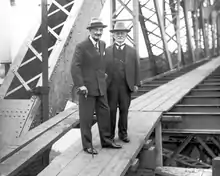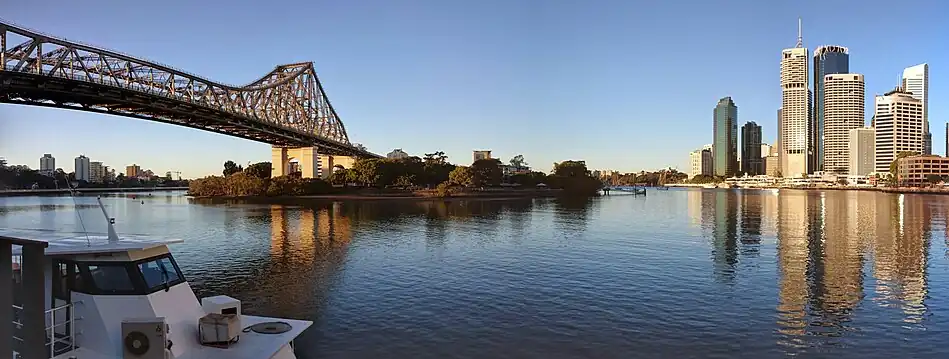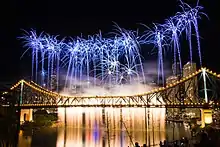Story Bridge | |
|---|---|
 | |
| Coordinates | 27°27′49″S 153°02′09″E / 27.4635°S 153.0358°E |
| Carries | Motor vehicles and pedestrians |
| Crosses | Brisbane River |
| Locale | Brisbane, Queensland, Australia |
| Official name | Story Bridge |
| Characteristics | |
| Design | Steel cantilever |
| Total length | 777 metres (2,549 ft) |
| Width | 24 metres (79 ft) |
| Height | 74 metres (243 ft) |
| Longest span | 282 metres (925 ft) |
| Clearance below | 30.4 metres (100 ft) at mid-span |
| History | |
| Opened | 6 July 1940 |
| Location | |
The Story Bridge is a heritage-listed steel cantilever bridge spanning the Brisbane River that carries vehicular, bicycle and pedestrian traffic between the northern and the southern suburbs of Brisbane, Queensland, Australia. It is the longest cantilever bridge in Australia.[1]
The road across the bridge is named Bradfield Highway. The bridge connects Fortitude Valley to Kangaroo Point. The Story Bridge opened in 1940 and was tolled until 1947. It is named after prominent public servant John Douglas Story.[1]
History
Given the early settlement of Kangaroo Point, there is a long history of residents wanting a bridge between the Brisbane CBD and Kangaroo Point. Even while the first Victoria Bridge was being constructed between North Brisbane and South Brisbane in 1865, several hundred people were petitioning for a second bridge to be built from the Customs House to Kangaroo Point.[2] In 1888, a meeting was held in the Brisbane Town Hall to demand a bridge connecting either George Street, Albert Street or Edward Street via the City Botanic Gardens with any loss of the land from the gardens to be potentially compensated by removing Government House.[3]
Planning
A bridge downstream of the Victoria Bridge was part of a larger plan, devised by Professor Roger Hawken of the University of Queensland in the 1920s, for a series of bridges over the Brisbane River to alleviate congestion on Victoria Bridge and to divert traffic away from the Brisbane central business district. The William Jolly Bridge was the first of the Hawken Plan bridges to be constructed. Lack of funds precluded the construction of the downstream bridge at that time. Initially plans called for a transporter bridge further downstream near New Farm.
In 1926 Kangaroo Point was recommended by the Brisbane City Council's Cross River Commission.[4] Subsequently, the bridge was constructed as a public works program during the Great Depression. The cost was to be no more than £1.6 million.[5]
%252C_circa_1934.jpg.webp)
Construction

Before the opening of the Sydney Harbour Bridge in 1932 the Government of Queensland asked John Bradfield to design a new bridge in Brisbane.
The Queensland Government appointed John Bradfield on 15 December 1933 as consulting engineer to the Bureau of Industry who were in charge of the construction of the bridge. In June 1934 Bradfield's recommendation of a steel cantilever bridge was approved. The design for the bridge was based heavily on that of the Jacques Cartier Bridge in Montreal, completed in 1930.[4] On 30 April 1935 a consortium of two Queensland companies, Evans Deakin and Hornibrook Constructions, won the tender with a bid of £1,150,000.[6][7]

Construction on the bridge began on 24 May 1935,[6] with the first sod being turned by the then Premier of Queensland, William Forgan Smith. Components for the bridge were fabricated in a purpose-built factory at Rocklea. There are 1.25 million rivets (metal pins or bolts) in the Story Bridge.[8] During its construction, work sometimes continued 24 hours per day.[5] The bridge has only one pier on the northern bank but two piers on the lower southern bank, one to bear the weight (the main pier) and, further to the south, one to prevent the bridge from twisting (the anchor pier). There was no need for an anchor pier on the northern bank as the bridge was anchored into schist cliff face. The primary challenge in constructing the bridge was the southern foundations that went 40 metres (130 ft) below ground level. It was not possible to excavate to that level as water from the river would rapidly seep in. So a pneumatic caisson technique had to be used. As men were working under pressures of up to 4 times normal air pressure, a decompression period of almost 2 hours was needed at the end of each shift to avoid the bends. An on-site air lock hospital successfully treated the 65 cases of the bends that occurred.[7] On 28 October 1939 the gap between the two sides was closed.[6] A concrete decking was then laid, covered by a Trinidad pitch topping. The bridge was painted and sodium lighting was installed. The bridge approaches were also prepared.[7]
Three men died during the construction of the bridge.[9] On 22 November 1937, Hans James Zimmerman slipped and fell 75 feet (23 m) to the ground.[10] On 7 February 1939, Alfred William Jackson fell from the bridge into the river. Although pulled from the water alive, he died 4 hours later in hospital without regaining consciousness.[11] On 6 December 1939, Arthur McKay (Max) Wharton was hit by a piece of equipment on a nerve that made him faint, falling from the bridge to the water; 18 months earlier Wharton saved another worker from falling from the bridge.[12]
A new underpass was created on the southside in 2023 to facilitate access to the Kangaroo Point Green Bridge.[1] It was designed for the passage of cyclists, scooters, runners, walkers and joggers.

Naming
Until it was completed, the bridge was known as the Jubilee Bridge in honour of King George V.[4] It was opened on 6 July 1940 by Sir Leslie Orme Wilson, Governor of Queensland and named after John Douglas Story, a senior and influential public servant who had advocated strongly for the bridge's construction.[6]
Operations


The bridge carries an average of 97,000 vehicles each day.[13] The Story Bridge carries three lanes of traffic in either direction as well as a shared pedestrian and cycle way flanking each side. The road on the bridge is called the Bradfield Highway. It is not to be confused with the Bradfield Highway that spans the Sydney Harbour Bridge.
Initially a toll of sixpence (5 cents) was charged to use the bridge,[5] with toll booths constructed at the southern end of the Bradfield Highway. The toll was removed in 1947.[14] Between 1952 and 1969 trolley-buses operated by the Brisbane City Council used the bridge.
Following completion of the bridge, an expressway was constructed on the southern side of the bridge (opened 18 May 1970),[15] and a tunnel/loop was constructed at Kemp Place on the northern side (completed 10 July 1972).[16]
Maintenance

Resurfacing works were undertaken in 1994.[17]
The Story Bridge was closed to traffic from midnight of Friday 3 January 2014 until 5.30 a.m. Monday, 6 January 2014, for essential maintenance work of resurfacing all six lanes.[18][19]
Closure for maintenance occurred again from 9 p.m. Friday 27 April 2018 until 5 a.m. Monday 30 April 2018.[20]
Role in contemporary Brisbane
The Story Bridge features prominently in the annual Riverfire fireworks display and is illuminated at night. In 1990, road traffic was halted so pedestrians could celebrate the 50th anniversary of the bridge's construction.[5] The bridge was again closed to road traffic on 5 July 2015 to celebrate the 75th anniversary. The celebration attracted almost 75,000 visitors to the bridge who enjoyed food, drink and entertainment as they walked across lanes usually reserved for vehicles.[21]
Bridge climbs began in 2005 and have become a popular tourist attraction.[22]
A picture of the bridge featured on Brisbane Bitter.[23]
Suicides
Similar to many large bridges such as the Golden Gate Bridge in San Francisco, Brisbane's Story Bridge has become notorious as a suicide hotspot.[24] Following two high-profile murder-suicides from the bridge in 2011 and 2012, Brisbane Lord Mayor Graham Quirk announced plans to install free telephones linked to suicide prevention hotlines.[24] On 6 February 2013, Quirk announced plans to install a three-metre-high safety barrier. Overall the plan cost about $8.4 million and was completed in December 2015.[25]
Heritage listing
The bridge was listed on the Queensland Heritage Register in 1992.[26]
In 1988, the bridge received a Historic Engineering Marker from Engineers Australia.[27]
In 2009 as part of the Q150 celebrations, the Story Bridge was announced as one of the Q150 Icons of Queensland for its role as a "structure and engineering feat".[28]
See also
- Australian landmarks
- Clem Jones Tunnel
- Jacques-Cartier Bridge
References
- 1 2 3 Moore, Tony (22 May 2023). "New walkway to link Story Bridge to city heart". Brisbane Times. Retrieved 1 June 2023.
- ↑ The Brisbane Courier. |date=16 March 1865 |access-date=6 August 2015 |page=2 |via=National Library of Australia}}
- ↑ "Brisbane River Bridge". The Telegraph. Brisbane. 3 November 1888. p. 2. Retrieved 6 August 2015 – via National Library of Australia.
- 1 2 3 Gregory, Helen (2007). Brisbane Then and Now. Wingfield, South Australia: Salamander Books. p. 92. ISBN 978-1-74173-011-1.
- 1 2 3 4 Hacker, D. R. (1999). Petries Bight: a Slice of Brisbane History. Bowen Hills, Queensland: Queensland Women's Historical Association Inc. pp. 45–46. ISBN 0-9590271-8-1.
- 1 2 3 4 Hogan, Janet (1982). Living History of Brisbane. Spring Hill, Queensland: Boolarong Publications. p. 109. ISBN 0-908175-41-8.
- 1 2 3 'Story Bridge: Idea to Icon' by Michael Moy, published Alpha Orion Press, Brisbane, 2005
- ↑ "Your Brisbane Bridge Climb Questions Answered!". Story Bridge Adventure Climb. 10 July 2018. Archived from the original on 4 March 2019. Retrieved 6 May 2019.
- ↑ "Bridge Cost Three Men Their Lives". The Courier-Mail. No. 2129. Brisbane. 29 June 1940. p. 18. Retrieved 8 June 2017 – via National Library of Australia.
- ↑ "FIRST STORY BRIDGE FATALITY". Queensland Times. Vol. LXXVIII, no. 15, 915. 23 November 1937. p. 7 (DAILY.). Retrieved 3 August 2017 – via National Library of Australia.
- ↑ "CARPENTER FALLS FROM STORY BRIDGE". The Central Queensland Herald. Vol. 10, no. 477. 9 February 1939. p. 41. Retrieved 3 August 2017 – via National Library of Australia.
- ↑ "100 ft. Death Fall From New Bridge". The Telegraph. Brisbane. 6 December 1939. p. 1 (CITY FINAL LAST MINUTE NEWS). Retrieved 3 August 2017 – via National Library of Australia.
- ↑ Kim Stephens & Cameron Atfield (2 January 2014). "Heatwave could see Brisbane reach 40 degrees". Brisbane Times. Archived from the original on 3 January 2014. Retrieved 2 January 2014.
- ↑ Brisbane 150 Stories. Brisbane City Council Publication. 2009. p. 183. ISBN 978-1-876091-60-6.
- ↑ Leighton Holdings Newsletter Archived 30 March 2012 at the Wayback Machine, June 1970
- ↑ Leighton Holdings Newsletter Archived 30 March 2012 at the Wayback Machine, August 1972
- ↑ Atfield, Cameron (4 January 2014). "Bridge crew have a hot Story to tell". Brisbane Times. Archived from the original on 5 July 2018. Retrieved 5 July 2018.
- ↑ Tin, Jason (4 January 2014). "Story Bridge to close for roadworks the first weekend of 2014". The Courier-Mail. Archived from the original on 25 December 2013. Retrieved 7 May 2018.
- ↑ "Story Bridge resurfacing works". Brisbane City Council. Archived from the original on 14 July 2014. Retrieved 7 May 2018.
- ↑ Hyam, Rebecca (27 April 2018). "Story Bridge water damage prompts two-day closure for repairs to southern approach". ABC News. Archived from the original on 29 April 2018. Retrieved 7 May 2018.
- ↑ Atfield, Cameron (5 July 2015). "Thousands flock to Story Bridge 75th birthday celebrations". Brisbane Times. Archived from the original on 7 July 2015. Retrieved 7 July 2015.
- ↑ Hutchinson, Amy (6 July 2010). "Seventy years on, Story Bridge still going strong". Brisbane Times. Archived from the original on 5 July 2018. Retrieved 5 July 2018.
- ↑ Michael Jackson (1984). The World Guide To Beer: The Brewing Styles, the Brands, the Countries. The Apple Press. p. 230. ISBN 9781850760009.
- 1 2 "Brisbane Times news article". 21 February 2012. Archived from the original on 23 February 2012. Retrieved 21 February 2012.
- ↑ "Safety barriers for Story Bridge". 6 February 2013. Archived from the original on 7 February 2013. Retrieved 6 February 2013.
- ↑ "Story Bridge (entry 600240)". Queensland Heritage Register. Queensland Heritage Council. Retrieved 13 December 2023.
- ↑ "Story Bridge, Brisbane River, 1940–". Engineers Australia. Archived from the original on 15 September 2016. Retrieved 9 September 2016.
- ↑ Bligh, Anna (10 June 2009). "PREMIER UNVEILS QUEENSLAND'S 150 ICONS". Queensland Government. Archived from the original on 24 May 2017. Retrieved 24 May 2017.
External links
- Story Bridge at Structurae
- Brisbane City Council – Captain Burke Park
- View on Google Maps – includes a short video.
- Urban design review of Story Bridge on citymakers.org
- Story Bridge Discovery Queensland Buildings website
- Story Bridge - History in Pictures, State Library of Queensland
- Story Bridge Construction Photograph Album 1931-1940, State Library of Queensland
- Story Bridge Photograph Albums 1934-1941, State Library of Queensland